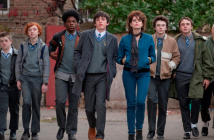
Editor’s Note: Backgammon opens in limited theatrical release today, March 11, 2016.
College kids Lucian (Noah Silver) and his girlfriend Elizabeth (Olivia Crocicchia) are spending a weekend with their friend Andrew (Christian Alexander) at his family’s estate. Lucian has developed a minor obsession with Gerald (Alex Beh), an eccentric artist who lives at the estate with Andrew’s sister Miranda (Brittany Allen). Even after the insufferable couple have chased Andrew and Elizabeth away, Lucian stays on at the mansion. But Gerald, after a thoroughly unpleasant fit of drunken rage, has disappeared, too, and if Miranda knows where he’s gone, she isn’t telling.
Meant to be an old-fashioned slow burn of a horror story with just a hint of polite, 1920s murder mystery, the film suffers from a fatal identity crisis, while being weighed down by some fairly awful performances.
 Backgammon, the debut feature film from Francisco Orvañanos, is based on the R.B. Russell novella Bloody Baudelaire. Where the novella opens with thick Gothic atmosphere and compellingly vague characters, the film adaptation falters and starts weak, then sadly never recovers. Meant to be an old-fashioned slow burn of a horror story with just a hint of polite, 1920s murder mystery, the film suffers from a fatal identity crisis, while being weighed down by some fairly awful performances. Beh as the indulgent and immoral artist Gerald puts in a truly embarrassing turn, the kind of performance you have to watch through your fingers. When he disappears, you’re as glad as Miranda seems to be, but not for the same reasons.
Backgammon, the debut feature film from Francisco Orvañanos, is based on the R.B. Russell novella Bloody Baudelaire. Where the novella opens with thick Gothic atmosphere and compellingly vague characters, the film adaptation falters and starts weak, then sadly never recovers. Meant to be an old-fashioned slow burn of a horror story with just a hint of polite, 1920s murder mystery, the film suffers from a fatal identity crisis, while being weighed down by some fairly awful performances. Beh as the indulgent and immoral artist Gerald puts in a truly embarrassing turn, the kind of performance you have to watch through your fingers. When he disappears, you’re as glad as Miranda seems to be, but not for the same reasons.
Lucian and Miranda are nearly as insufferable as Gerald, mostly because the actors are clearly grappling with roles they don’t understand, struggling to differentiate between what is affectation and what is genuine life experience. Scene after scene reads like schoolkids putting on a Reader’s Digest condensed version of a Harold Pinter play in their own backyard; one line reading about the estate’s conservatory is particularly bad, evoking childhood games of Clue rather than the crumbling decadence intended. There’s even an early scene (and a little dialogue) borrowed from The House of Yes (1997), though with less incest and more scenery chewing.
Scene after scene reads like schoolkids putting on a Reader’s Digest condensed version of a Harold Pinter play in their own backyard.
With the house to themselves, Miranda and Lucian engage in a tepid bit of cat-and-mouse, which involves interminable conversations about nothing of note. A romance threatens to brew, but never materializes. There is no intrigue or sexual tension between the two, only dull confusion. Miranda is a dopey little girl, though surely meant to be fascinating and mercurial. It’s impossible to believe that Lucian, despite being no great thinker — he is, in fact, probably the only Yalie who knows not one syllable of Baudelaire — would take any of her evasive, contradictory statements at face value. If anything, he should be laughing his socks off at her sad attempts to play the mysterious vamp, but he’s too busy taking showers to notice anything is awry.
Amid the overbearing score and under-furnished sets is some really lovely cinematography, courtesy Simon Coull. The outdoor scenes are especially well done, featuring glowing fall days in one of the more beautiful areas of Maine, with a couple of sweeping aerial shots that are truly impressive. It’s gorgeous to look at, though perhaps looking so good does the film a disservice, as it makes us expect more than the movie could ever possibly give.
With poor performances, murky motivations and stilted dialogue that rarely makes sense, Backgammon is less a psychological drama than it is a trudge to get through.



